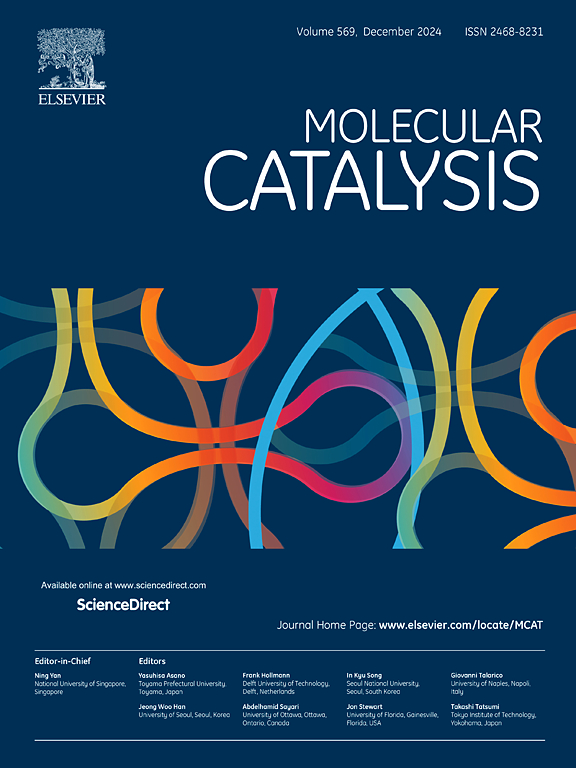Cu NPs@covalent organic framework: An efficient photocatalyst for light-assisted selective formylation of phenol derivatives utilizing carbon dioxide
IF 4.9
2区 化学
Q2 CHEMISTRY, PHYSICAL
引用次数: 0
Abstract
Our study presents a novel synthetic approach for the visible-light-assisted photocatalytic production of 2-hydroxybenzaldehyde from phenol via CO2 reduction, using copper nanoparticles (Cu NPs)-incorporated two-dimensional covalent organic framework (TR-PDA COF) photocatalyst. The Cu@TR-PDA catalyst exhibited a low band gap energy (2.14 eV), enabling efficient visible light absorption and photocatalytic activity. Under optimized conditions, this catalyst achieved 87 % conversion of phenol to 2-hydroxybenzaldehyde under 20 W white LED light. The reaction was light-dependent and required a base. Mechanistic studies revealed that formaldehyde (HCHO), generated from CO2 photoreduction, served as a key intermediate, which reacted with phenol to form the desired product. Furthermore, the Cu@TR-PDA catalyst demonstrated excellent reusability over six cycles, and showed minimal metal leaching, confirming its heterogeneous nature. This work offers a promising strategy for the sustainable conversion of CO2 into valuable chemicals using a metal-based photocatalyst under visible light.

Cu NPs@covalent有机骨架:利用二氧化碳进行光辅助选择性甲酰化苯酚衍生物的高效光催化剂
本研究提出了一种利用纳米铜颗粒(Cu NPs)结合二维共价有机框架(TR-PDA COF)光催化剂,通过CO2还原苯酚,在可见光辅助下合成2-羟基苯甲醛的新方法。Cu@TR-PDA催化剂具有较低的带隙能量(2.14 eV),具有高效的可见光吸收和光催化活性。在优化条件下,该催化剂在20 W白光LED下,苯酚转化为2-羟基苯甲醛的转化率达到87%。该反应依赖于光,需要碱。机理研究表明,CO2光还原生成的甲醛(HCHO)作为关键中间体,与苯酚反应生成所需产物。此外,Cu@TR-PDA催化剂在6个循环中表现出优异的可重复使用性,并且金属浸出最小,证实了其多相性质。这项工作为在可见光下使用金属基光催化剂将二氧化碳可持续地转化为有价值的化学品提供了一个有前途的策略。
本文章由计算机程序翻译,如有差异,请以英文原文为准。
求助全文
约1分钟内获得全文
求助全文
来源期刊

Molecular Catalysis
Chemical Engineering-Process Chemistry and Technology
CiteScore
6.90
自引率
10.90%
发文量
700
审稿时长
40 days
期刊介绍:
Molecular Catalysis publishes full papers that are original, rigorous, and scholarly contributions examining the molecular and atomic aspects of catalytic activation and reaction mechanisms. The fields covered are:
Heterogeneous catalysis including immobilized molecular catalysts
Homogeneous catalysis including organocatalysis, organometallic catalysis and biocatalysis
Photo- and electrochemistry
Theoretical aspects of catalysis analyzed by computational methods
 求助内容:
求助内容: 应助结果提醒方式:
应助结果提醒方式:


